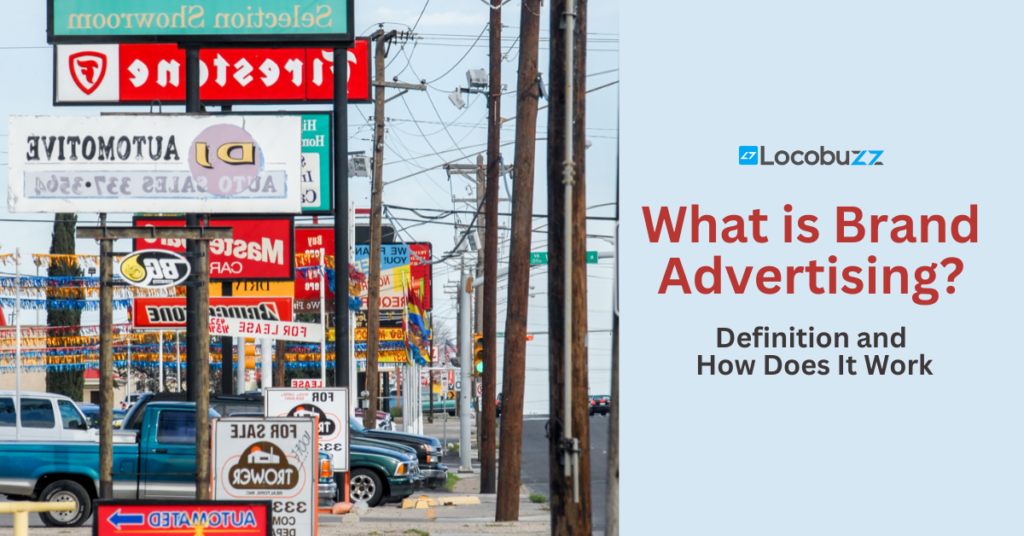What is Brand Advertising Definition and How Does It Work

What is Brand Advertising?
Brand advertising is a marketing strategy focused on creating and promoting a strong, positive image of a company’s brand. Unlike direct response advertising, which urges consumers to take immediate action, such as making a purchase or signing up for a newsletter.
The main goal is to create a positive image, build trust, and make lasting connections with customers.. It’s about more than just selling products; it’s about getting people to believe in what the brand stands for. Brand ads use things like catchy tunes, images, and memorable phrases to make a quick and positive impression. The focus is on building strong, long-lasting relationships with customers, going beyond just making one-time sales. In simpler terms, brand advertising aims to make more people aware of the brand, reach a bigger audience and show off the brand’s strengths and advantages.
The endgame is to boost sales. At the heart of brand advertising is creating a unique identity for the brand. This identity helps customers recognize the brand among all the others out there. The idea is to build a good reputation and make customers feel connected to the brand emotionally and intellectually.
In the current highly competitive market, only the most robust and reliable brands manage to thrive. It’s a reciprocal process: initially, businesses put in the effort to establish their brand, and over time, the brand starts working in their favor. For a business to have staying power, it’s crucial to begin the process of building and advertising the brand early on. This isn’t just an expense; it’s an investment in the future that yields returns by making the brand easily recognizable and ensuring that customers keep coming back.
What does branding include?
Branding encompasses a range of elements crucial for establishing a distinct identity in the market. These elements collectively form the brand identity, influencing consumer perceptions and choices. Key components of branding include:
Name: The brand name is a fundamental aspect of branding. It is the identifier that consumers associate with a particular product or service. A well-chosen name can convey the essence of the brand and leave a lasting impression.
Logo: The logo is a visual representation of the brand and is often the first thing consumers recognize. It appears on all brand-related materials and products, making it a vital aspect of brand identity. The colors, fonts, and images used in a logo should be unique and easily identifiable.
Packaging: The way a product is packaged contributes to its overall branding. Packaging design, colors, and materials can influence consumer perception and play a role in attracting attention on store shelves.
Pricing: The pricing strategy adopted by a brand is an integral part of its identity. Whether positioned as a premium or budget-friendly option, pricing communicates the brand’s perceived value and target market.
Values and Mission: The underlying values and mission of a company shape its brand identity. These elements go beyond the physical product and contribute to the overall brand image. Consumers often connect with brands that share their values.
Slogan: A memorable slogan or tagline complements the logo and serves as a concise expression of the brand’s message. It adds context to the brand, helping consumers understand what the organization stands for and what they can expect.
Sponsorship: Establishing credibility is crucial for building consumer trust. Companies often engage in sponsorships, supporting charities or community events, to showcase their commitment to social responsibility. This involvement contributes to the overall perception of the brand.
Consistency: Maintaining consistency across all brand elements is essential. From the logo to the messaging, a cohesive and uniform presentation reinforces the brand identity and helps consumers easily recognize and remember the brand.
In brand advertising, understanding and leveraging these elements are vital for reaching consumers effectively and fostering customer loyalty. By carefully crafting and managing these aspects, organizations can build a strong brand presence that resonates with their target audience and sets them apart in the competitive market.
Unlock the full potential of your brand with Locobuzz! Dive into a world of advanced analytics and transformative insights.
How Brand Advertising Works
Research and Audience Analysis:
Brand advertising kicks off with a thorough exploration of the market and a deep dive into understanding the target audience. Through detailed research, brands uncover not only the demographic details of their audience but also their needs, preferences, and behavioral patterns. Audience analysis becomes a crucial compass, guiding brands in tailoring messages that resonate specifically with the identified demographics. This step forms the bedrock for crafting a campaign that genuinely connects with the intended audience.
Brand Strategy:
Informed by research findings, the brand strategy takes shape as a comprehensive blueprint. This document outlines the brand’s overarching goals, core values, positioning in the market, and the messaging it aims to convey. A well-defined strategy becomes the guiding force behind all advertising efforts, ensuring a consistent and cohesive presentation of the brand’s identity across diverse advertising channels. It serves as the North Star that aligns every aspect of the brand’s communication.
Visual Identity:
Visual elements, such as logos, color schemes, and typography, are meticulously crafted to encapsulate the brand’s personality and values. These elements transcend mere aesthetics; they become visual cues that consumers associate with the brand. The visual identity is a powerful tool for brand recognition and plays a pivotal role in creating a lasting and memorable brand image. Consistency in these visual elements across various platforms reinforces the brand’s identity.
Content Creation:
The heart of brand advertising lies in the creation of compelling and engaging content. This content serves as the brand’s voice, reaching out to the target audience through various mediums. Whether through blog posts, social media updates, videos, or other formats, the content aligns with the brand’s messaging and is tailored to resonate with the preferences of the target audience. The goal is not just to convey information but to create a meaningful connection with consumers.
Multi-Channel Promotion:
Brands recognize the importance of reaching consumers where they are, and hence, employ a diverse range of channels for promotion. Social media, email marketing, content marketing, influencer collaborations, and traditional advertising methods all play a role. The strategy involves a mix of these channels to ensure a broad reach, engaging the audience through multiple touchpoints. This multi-channel approach reflects an understanding of the varied ways in which consumers interact with brands in today’s dynamic landscape.
Monitoring and Adaptation:
The landscape of brand advertising is dynamic, requiring continuous social media monitoring and adaptation. Brands must gather analytical data to evaluate the performance of their advertising efforts. This data-driven approach allows them to make informed adjustments to their strategies. It’s a cycle of constant improvement, ensuring that the brand remains relevant and effective in the ever-evolving market. Adaptation is key to staying ahead and meeting the changing expectations of the audience.
Building Trust and Loyalty:
The ultimate goal of brand advertising is the cultivation of trust and loyalty over time. As consumers consistently encounter and resonate with the brand’s messaging, a sense of trust develops. This trust transforms into loyalty, leading to repeat business and positive word-of-mouth recommendations. The enduring success of brand advertising lies in this ability to create a positive and lasting connection with consumers, solidifying the brand’s identity as a trusted and preferred choice in the market.
Brand Advertising Strategies
Strategic Positioning:
Understanding the competition is not only about gathering data; it’s about strategic positioning. Brands analyze competitors not just for market trends but to identify gaps or unmet needs in the market. This analysis aids in positioning the brand uniquely, offering something distinctive that competitors might overlook.
SWOT Analysis:
A comprehensive strategy involves conducting a SWOT analysis—evaluating the brand’s Strengths, Weaknesses, Opportunities, and Threats. This internal and external assessment provides a holistic view, guiding strategic decisions and helping in mitigating potential risks.
Lifecycle Marketing:
Building on customer research, brands implement lifecycle marketing strategies. Recognizing that customers go through different stages in their relationship with a brand—from awareness to loyalty—enables the creation of targeted content and experiences tailored to each stage of the customer journey.
Personalization and Customization:
Content creation extends to personalization and customization. Brands leverage data from customer research to tailor messages and offers based on individual preferences. Personalized experiences make customers feel seen and valued, fostering a stronger connection with the brand.
Data-Driven Decision Making:
Incorporating data-driven decision-making is pivotal. Brands leverage analytics and key performance indicators (KPIs) to measure the success of advertising strategies. This data informs future decisions, enabling brands to optimize campaigns, allocate resources effectively, and stay agile in a dynamic market.
Community Engagement:
Going beyond influencers, brands actively engage with their community. This involves responding to customer comments, participating in online forums, and encouraging user-generated content. A thriving community becomes an extension of the brand, fostering loyalty and advocacy.
Storytelling:
Content creation is elevated through storytelling. Brands craft narratives that go beyond product features, creating stories that evoke emotions and connect with the audience on a human level. This narrative-driven approach helps in building a brand personality that consumers can relate to.
Continuous Feedback Loop:
In the ever-evolving landscape of brand advertising, feedback is a continuous loop. Brands actively seek feedback from customers, analyze performance metrics, and listen to social conversations. This ongoing dialogue ensures that the brand remains attuned to the changing needs and expectations of its audience.
Incorporating these expanded strategies into the brand advertising process enriches the approach, fostering a holistic and adaptable strategy that resonates with the target audience and positions the brand for sustained success in the market.






















